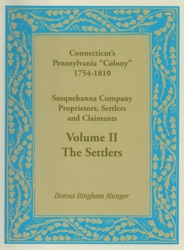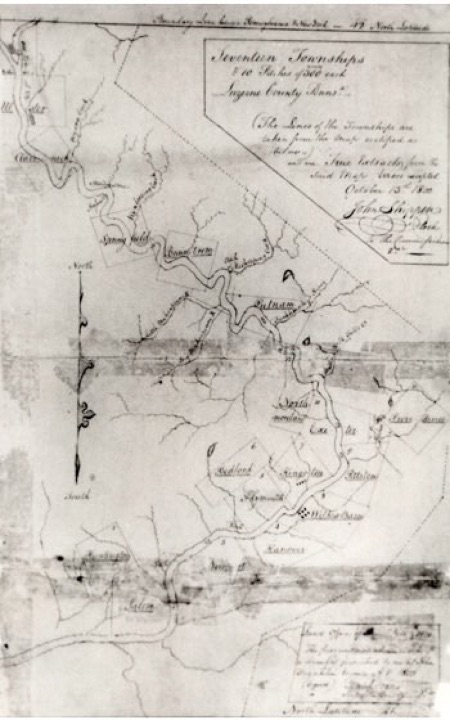DONNA BINGHAM MUNGER
My Own Website
Author, Educator, Historian, Genealogist


DONNA BINGHAM MUNGER
My Own Website
Author, Educator, Historian, Genealogist
INTRO
DONNA’S
PAGE
BINGHAM
STUFF
MUNGER MATTER
MICHAEL SPRINGLE
(SPRINKLE, SPRENGLE, SPRENKLE)
IN PENNSYLVANIA
SUSQUEHANNA
COMPANY
COLLECTION
PENNSYLVANIA
LAND
RECORDS
OTHER RESEARCH


Pennsylvania “Colony”
1754-1810
Susquehanna Company
Proprietors, Settlers
and Claimants
Volume II
The Settlers
The Connecticut based Susquehanna Company perpetrated one of the greatest land schemes of all times. Arguing that the unsettled Susquehanna River region in the colony of Pennsylvania lay within the charter bounds of the colony of Connecticut, the Company sold rights to land along the East and West Branches of the Susquehanna River. To justify its actions, the Company negotiated a deed with the Indians of the Six Nations conveying the Wyoming region in Pennsylvania to Company proprietors, also called shareholders. For the next fifty years Company settlers, mainly from Connecticut, streamed into northeastern Pennsylvania. Holding title to their land only by virtue of deeds recorded in Company Account Books, the settlers disappeared from legal court records.

Volume II makes the task of searching multiple sources manageable and the information understandable by merging thirty-two lists of settlers into one database. The sources begin with a deposition recalling the names of thirteen of the first Susquehanna Company settlers in June 1762 and end with 1150 names on a November 1801 petition to the United States Congress asking for additional consideration and relief. In between, the lists range from the names of the 31 of the “First Forty” present and arrested at Wyoming in March 1769, to a list of the proprietor-settlers of the first five townships in June 1770, and tax lists for 1776-1780.
The Seventeen Certified Townships of the Susquehanna Company
Original in Names of Releasors - John and Richard Penn by Their Attorney Edmond Physick, Vol. A
Land Records Collection, Pennsylvania State Archives
For each person named in a list the database cites date and place present. Many individuals appear on several of the lists as the database clearly shows. As with all publications choices needed to be made so the lists of inhabitants of individual towns at a given time gave way to lists of a more comprehensive nature. Most of the short, township specific lists are printed in early county histories and available on the Internet.
To access the alphabetical database of settlers: name, date present, place, source, you need to use this Volume II.
Use worldcat.org to find Volume II, The Settlers, in a library near you.
Use heritagebooks.com or Amazon.com to buy Volume II. This is not advertising. In return for publication, I gave Heritage Books the royalty income, although I hold the copyright.
All Volumes (I, II, III) may be obtained in the same way.
To buy a searchable, archival quality, at cost, CD of Volumes I, II, III databases contact me. (dgbmunger@gmail.com)
Donna Bingham Munger asserts her right to be identified as the author of this website.